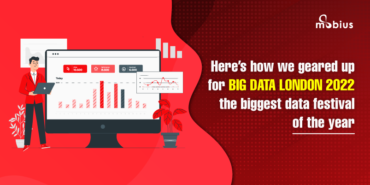Large and Luxurious has become a way of life for the city of impeccable architecture and style – Dubai. Apart from being the largest among UAE cities, it houses the world’s tallest building, biggest natural flower garden, the most massive mall, world’s heaviest Gold Ring, extensive artificial islands, and the planet’s most luxurious 7-star hotel.
Click here to download our detailed whitepaper on the role of data analytics in Aviation sector
Looking at the huge strides made by Dubai’s aviation industry in the past decade, the list is bound to grow. With the Dubai International Airport transporting roughly 84 million passengers in 2016 – a rapid 7.2% increase since 2015, it clinched the title of being the world’s largest airports by international passenger traffic and the third largest in terms of freight and cargo.
Dubai International Airport is now a key contributor to the city’s economy occupying 27% of the GDP and 21% of Dubai’s employment. The Airport’s CEO Paul Griffiths aims at increasing the airport’s capacity to 142 million passengers by 2025.
Application of technology especially airline data analytics is what he believes in. Rather than scaling the visible size of the airport, the ‘Dubai masterplan’ is looking for ways to increase the throughput of a terminal thus doubling its capacity.
The Big Data Answer to Aviation woes
Dubai Airport is not the lone adopter of technology in optimizing their operations. Miami International Airport has introduced an app that helps in way-finding for passengers within the airport premises tapping on information gathered accurately in real time.
Airline companies are leaving no stone unturned too, what with all the soaring competition in their business. Means to reduce flight delays, enhance in-flight entertainment, fine-tune loyalty programs, and ticket offers are considered by looking at scores of passenger data that are made available to them. Anything to catch the eye of the air commuter.
Data is definitely in the air. Have you seen all of it?
At the heart of all these tech initiatives is the common thought to give a hassle-free journey to that excited family visiting their loved one in a faraway land, to that executive giving his first presentation at the elite board meet, and to that free soul that is yearning for a much-needed time off.
Applying data insights in the following six trending technologies will have major returns in the Aviation sector.
Baggage no longer a burden
About 5.73 bags per thousand passengers were mishandled in 2016.
Baggage mishandling is a serious concern to the aviation industry.This not only results in losing millions of dollars (compensation) but also losing valuable customers.
Radio-frequency identification is the way to minimize baggage mishandling, replacing the barcode hand scanning that can help in minimizing baggage claims, prevent journey disruption and improve handling efficiency. Implementation of the RFID technology is also mandated as per IATA Resolution 753 to reduce mishandling.
Scanners use radio waves to capture data stored in the RFID chip that is embedded in the luggage tag. This data will enable the travelers to track their bags on and off the aircraft during their journey through push notifications.
Data Beacons to ease airport way-finding
Finding your way through acres of airport space, especially in a foreign terrain could be quite daunting. Understanding this common pain point of passengers, as per the SITA 2017 Air Transport IT Trends report, 74% of airports are investing or planning to invest in way-finding solutions over the next 3 years.
Data beacons placed at various points in the airport communicate with a passenger’s phone and just like navigating with a g-map on road, passengers can get accurate directions towards their places of check-in, departure gates, and nearby retail outlet details.
Benefits of beacon navigation solutions are already felt in Miami International airport and UK’s second busiest airport at Gatwick, with the latter integrating Augmented Reality in their way-finding solution.
Optimize ground-air coordination with handy real-time data
The Aviation sector is quite vast and complex broadly involving airlines, airports, governments, ground handlers and retailers. Functioning of each category by itself incorporates various other stakeholders and piecing it all together is definitely challenging.
A technical glitch in aircraft, flooded runway, horrendous weather, or a dispute-caused long queue keep the frustrated passenger clueless and personnel scurrying to ease the blow of a resentful journey. Airlines incur a cost of about $20 Billion annually to manage disruptions due to cancellation and rescheduling of flights. In 2015, major airlines incurred delay costs of about $25 Billion annually to manage disruptions due to cancellation and rescheduling of flights.
Barriers between the data silos need to be broken and integrated to provide a holistic view to the staff at airport and airlines, air traffic controllers, and ground handlers. Meaningful insights like actual queue length at a gate can enable airport teams to manage and handle queues effectively.
This would heighten the overall operational efficiency by making informed decisions in terms of crew deployment and alternate arrangement to combat disruptions.
Develop the personalized bond with your fliers – Be their first choice always
Let’s face it. You and I always try to find the best fit in everything – clothing, jobs, accommodations etc.., at the most economical price.
Folks traveling with your airline are also seeking for the same. Data on frequent destinations, time of travel, offers chosen in the past and social media sentiments are all available for the airline community to personalize their offers.
Finding your traveler’s hotel and taxi preferences through data mining and offering relevant discounts at the time of ticket purchase is another way to stay ahead of your counterparts.
Rigorous big data analytics on the density of travelers in various route helps the airline management to optimize their route networks and introduce new destinations with pleasing offers according to seasonal variations.
Monitor air carrier health with sensor data
One of the strategic predictions made by Gartner in 2017 is that IoT will save consumers and businesses $1 trillion a year in maintenance, services, and consumables by 2020.
They also estimate that if data from the IoT enabled large passenger and cargo aircraft assets is put to proper use, savings of $70 Billion per year can be seen worldwide.
A major airline in the US sees 44% of its expense directed towards aircraft operating expense, which includes fuel, direct maintenance, depreciation, and crew. Predictive analysis of the real-time status and health of aircraft components helps assess when maintenance (physical parts replacement, fuel usage improvement, and workforce deployment) is required rather than inclining towards a routine-based approach.
Since there is an overdose of information involved, airline industries look up to big data solutions outside their sphere to play with the diagnostic information.
Sense your customers’ social media sentiments
Today’s travelers are fully equipped with every bit of information, thanks to social media and the airlines that have given travelers an opportunity to share their concerns that will help in resolving them to serve better.
KLM is one among the best airlines on social media that handles up to 40,000 passenger queries in a week on Twitter and Facebook.
A great deal of travelers carry electronic gadgets during travel and a majority of them take social media as a forum to shout out their complaints and pour their appreciation by explicitly hashtagging the airlines that they travel in. This helps the airlines to track them down with the help of data available with them to instantly resolve their concerns.
Real-time data analytics of social media posts help airlines respond to constructive criticisms and negative feedback in the right way.
Create seamless journeys with Data
The huge potential hidden in latest tech buzzwords like Big Data, Machine learning, and IoT can be realized in the Aviation sector when all the available data is pooled in and analytics is applied on them to turn them into actionable intelligence.
The underlying force is undoubtedly data and we at Mobius have been feeding fresh and accurate data from over 93,000 flights in 300+ airports to an air travel intelligence giant at real-time. Overcoming time zone and language challenges, varied data pertaining to flight number, scheduled and the actual time of take-off, airborne, touchdown and landing are constantly tracked.
Up to date information of runway, departure and arrival gates, terminals are also aggregated round the clock and it’s no wonder we’ve received a pat on the back for supplying supremely reliable data. Check out the solutions we are providing to this leading air travel intelligence company.
Connect with us to know more on how our mix of in-house products and services can aggregate real-time flight related data and aid in your business take-off!







